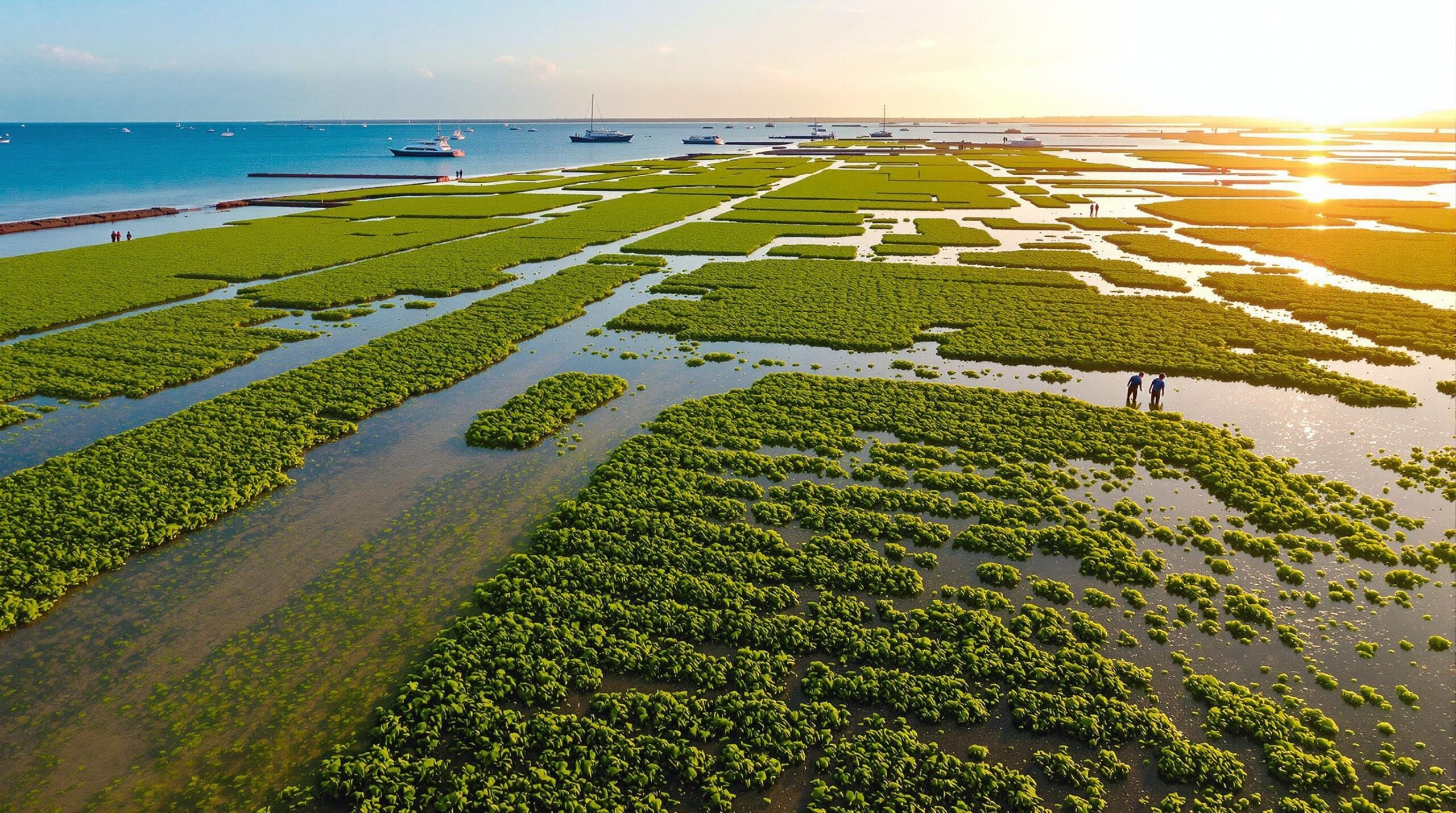Seaweed farms are rapidly emerging as key players in the global movement toward sustainable agriculture. These innovative operations harness the unique properties of seaweed, offering a powerful solution to numerous environmental and agricultural challenges. As interest grows, seaweed farming is set to play a significant role in the future of farming worldwide.
What Makes Seaweed Farming Unique?
Unlike land-based crops, seaweed requires no soil, freshwater, or chemical fertilizers to thrive. Instead, it grows in oceans, lakes, and coastal waters, drawing nutrients directly from its aquatic environment. This makes seaweed an extraordinarily efficient crop with a small ecological footprint.
Seaweed also grows quickly, often doubling its biomass in just a matter of weeks. This rapid growth surpasses most terrestrial crops. Because it does not compete with food crops for arable land, seaweed farming avoids common agricultural conflicts.
As a result, seaweed cultivation can flourish in locations unsuitable for traditional agriculture. This unique quality offers hope for regions facing land degradation or freshwater scarcity.
Environmental Benefits of Seaweed Farms
Seaweed absorbs high amounts of carbon dioxide and other greenhouse gases during growth. By capturing carbon, seaweed helps mitigate climate change and ocean acidification.
Further, seaweed acts as a natural water filter. It absorbs excess nutrients such as nitrogen and phosphorus from the water, improving marine water quality. This can counteract the effects of agricultural runoff, which often causes harmful algal blooms.
Additionally, seaweed farms provide essential habitats for marine life. Fish and invertebrates use these underwater forests for breeding and protection, enhancing local biodiversity.
Innovative Farming Techniques and Technologies
Modern seaweed farms rely on advanced techniques to boost productivity and sustainability. Open-ocean farming uses floating ropes and racks, providing optimal growing conditions while reducing coastal congestion.
Researchers have developed automated monitoring systems to track water conditions and crop health. These systems use sensors and data analytics, allowing farmers to react quickly to changes.
Hybrid farms now combine seaweed with other aquaculture products, such as shellfish. This integrated approach creates a closed-loop system. Seaweed absorbs waste from shellfish, while shellfish benefit from cleaner water and natural food sources.
Seaweed’s Contributions to Sustainable Agriculture
Seaweed is rich in essential nutrients and bioactive compounds, making it a valuable organic fertilizer for terrestrial crops. Seaweed-based fertilizers help improve soil structure, boost plant growth, and increase resistance to pests and diseases.
Farmers can reduce reliance on synthetic fertilizers, which often cause environmental harm via runoff and emissions. As demand for organic produce grows, seaweed fertilizer fits perfectly with regenerative agriculture practices.
Seaweed extracts also offer natural alternatives to chemical pesticides. Some species produce compounds that deter harmful insects and fungal pathogens, protecting vulnerable crops.
Economic Opportunities and Community Impact
Seaweed farming brings new economic opportunities, especially for coastal communities. These farms create sustainable jobs in production, processing, and research. They can revitalize regions affected by declining fisheries or agricultural productivity.
Women and marginalized groups have found new roles in seaweed farming ventures. This industry promotes inclusivity, supporting both large and small-scale operations. New partnerships between local governments and private companies further drive growth.
On a global scale, the seaweed industry’s value reached almost $15 billion in 2021. Projections indicate rapid expansion, especially as countries seek sustainable food and resource alternatives.
Seaweed in the Circular Bioeconomy
Beyond fertilizers and food, seaweed’s versatility supports the transition to a circular bioeconomy. Its biomass can be converted into biofuels and bioplastics, offering renewable alternatives to fossil-based products.
Seaweed extracts are used in cosmetics, pharmaceuticals, and animal feed, minimizing waste and maximizing value from every harvest. This multi-use approach aligns with sustainability and resource efficiency goals.
Researchers are also developing new methods to capture carbon credits from seaweed cultivation. These credits could finance further innovation and expand the reach of sustainable practices.
Challenges and the Path Forward
Despite its promise, seaweed farming faces significant challenges. Regulatory frameworks, access to finance, and technological barriers can hinder large-scale adoption. Some regions still lack clear guidelines for farm placement and environmental monitoring.
Investment in research and development remains critical for advancing cultivation methods and product applications. Training programs can help new farmers adopt best practices and boost productivity.
Collaboration between governments, scientists, and industry leaders is essential for removing obstacles. Continued cooperation will unlock seaweed’s full potential and facilitate its role in global food systems.
Case Studies: Success from Around the World
In Norway and Ireland, seaweed farms operate within cold Atlantic waters, supplying ingredients to health food, animal feed, and bio-packaging industries. These farms use both traditional and innovative cultivation techniques.
In Asia, particularly in Indonesia, China, and South Korea, seaweed farming has supported millions of livelihoods for generations. Producers there have developed efficient harvesting and processing systems, serving global markets.
Along the coasts of North America and Australia, pioneering companies have established environmentally conscious seaweed farms. Many work alongside researchers to develop carbon-neutral and even carbon-negative technologies.
The Future of Seaweed Farms in Sustainable Agriculture
Seaweed farms have the power to reshape sustainable agriculture. Continued innovation and policy support will determine how quickly the sector grows and integrates with food and energy systems.
With minimal inputs and multiple uses, seaweed fills critical gaps in the quest for sustainable food and resource production. The transition to circular and nature-positive agriculture depends on harnessing diverse solutions like seaweed farming.
By embracing these innovative farms, societies can protect marine environments, strengthen food security, and unlock new economic pathways. The coming decades may well see seaweed thrive as a core pillar of agriculture’s future.

